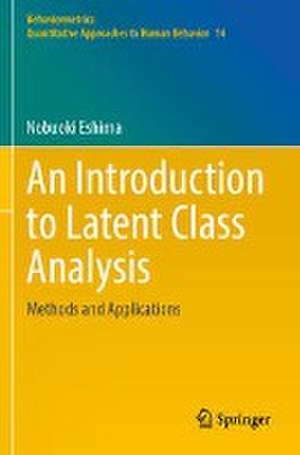An Introduction to Latent Class Analysis: Methods and Applications: Behaviormetrics: Quantitative Approaches to Human Behavior, cartea 14
Autor Nobuoki Eshimaen Limba Engleză Paperback – 11 apr 2023
| Toate formatele și edițiile | Preț | Express |
|---|---|---|
| Paperback (1) | 692.24 lei 6-8 săpt. | |
| Springer Nature Singapore – 11 apr 2023 | 692.24 lei 6-8 săpt. | |
| Hardback (1) | 698.47 lei 6-8 săpt. | |
| Springer Nature Singapore – 10 apr 2022 | 698.47 lei 6-8 săpt. |
Din seria Behaviormetrics: Quantitative Approaches to Human Behavior
- 18%
 Preț: 780.82 lei
Preț: 780.82 lei - 18%
 Preț: 953.65 lei
Preț: 953.65 lei - 18%
 Preț: 775.96 lei
Preț: 775.96 lei - 15%
 Preț: 633.02 lei
Preț: 633.02 lei - 18%
 Preț: 777.20 lei
Preț: 777.20 lei - 18%
 Preț: 904.60 lei
Preț: 904.60 lei - 15%
 Preț: 688.16 lei
Preț: 688.16 lei - 18%
 Preț: 892.59 lei
Preț: 892.59 lei - 18%
 Preț: 1124.78 lei
Preț: 1124.78 lei - 18%
 Preț: 892.90 lei
Preț: 892.90 lei - 18%
 Preț: 943.43 lei
Preț: 943.43 lei - 18%
 Preț: 1116.57 lei
Preț: 1116.57 lei - 18%
 Preț: 790.28 lei
Preț: 790.28 lei - 18%
 Preț: 773.20 lei
Preț: 773.20 lei - 18%
 Preț: 940.25 lei
Preț: 940.25 lei - 18%
 Preț: 888.01 lei
Preț: 888.01 lei - 18%
 Preț: 718.65 lei
Preț: 718.65 lei - 26%
 Preț: 405.89 lei
Preț: 405.89 lei - 26%
 Preț: 524.36 lei
Preț: 524.36 lei
Preț: 692.24 lei
Preț vechi: 814.40 lei
-15% Nou
Puncte Express: 1038
Preț estimativ în valută:
132.48€ • 137.80$ • 109.37£
132.48€ • 137.80$ • 109.37£
Carte tipărită la comandă
Livrare economică 15-29 aprilie
Preluare comenzi: 021 569.72.76
Specificații
ISBN-13: 9789811909740
ISBN-10: 9811909741
Pagini: 190
Ilustrații: XI, 190 p. 45 illus., 1 illus. in color.
Dimensiuni: 155 x 235 x 12 mm
Greutate: 0.29 kg
Ediția:1st ed. 2022
Editura: Springer Nature Singapore
Colecția Springer
Seria Behaviormetrics: Quantitative Approaches to Human Behavior
Locul publicării:Singapore, Singapore
ISBN-10: 9811909741
Pagini: 190
Ilustrații: XI, 190 p. 45 illus., 1 illus. in color.
Dimensiuni: 155 x 235 x 12 mm
Greutate: 0.29 kg
Ediția:1st ed. 2022
Editura: Springer Nature Singapore
Colecția Springer
Seria Behaviormetrics: Quantitative Approaches to Human Behavior
Locul publicării:Singapore, Singapore
Cuprins
Overview of Basic Latent Structure Models.- Latent Class Cluster Analysis.- Latent Class Analysis with Ordered Latent Classes.- Latent Class Analysis with Latent Binary Variables: Application for Analyzing Learning Structures.- The Latent Markov Chain Model.- Mixed Latent Markov Chain Models.- Path Analysis in Latent Class Models.
Notă biografică
Nobuoki Eshima was born in Fukuoka, Japan, in 1957. He was received B.Sc. and D.Sc. degrees in Mathematics from Kyushu University, Fukuoka, Japan, in 1980 and 1993, respectively. In 1993, he joined Department of Statistics, Faculty of General Education, Nagasaki University, as Associate Professor. In 1996, he joined Department of Medical Information Analysis, Faculty of Medicine, Oita Medical University, as Professor. In 2016, he joined Center for Educational Outreach and Admissions, Kyoto University, as Professor. In 2021, he was granted the title of Emeritus Professor of Oita University, and from 2021, he is Guest Professor of Faculty of Medicine, Kurume University.
Textul de pe ultima copertă
This book provides methods and applications of latent class analysis, and the following topics are taken up in the focus of discussion: basic latent structure models in a framework of generalized linear models, exploratory latent class analysis, latent class analysis with ordered latent classes, a latent class model approach for analyzing learning structures, the latent Markov analysis for longitudinal data, and path analysis with latent class models. The maximum likelihood estimation procedures for latent class models are constructed via the expectation–maximization (EM) algorithm, and along with it, latent profile and latent trait models are also treated. Entropy-based discussions for latent class models are given as advanced approaches, for example, comparison of latent classes in a latent class cluster model, assessing latent class models, path analysis, and so on. In observing human behaviors and responses to various stimuli and test items, it is valid to assume they are dominatedby certain factors. This book plays a significant role in introducing latent structure analysis to not only young researchers and students studying behavioral sciences, but also to those investigating other fields of scientific research.
Caracteristici
Discusses exploratory latent class models, confirmatory latent class models, and the latent Markov chain models Provides entropy-based discussions for assessing latent class models by using Kullback–Leibler information Presents an entropy-based path analysis for generalized linear models for causal systems based on latent class models
